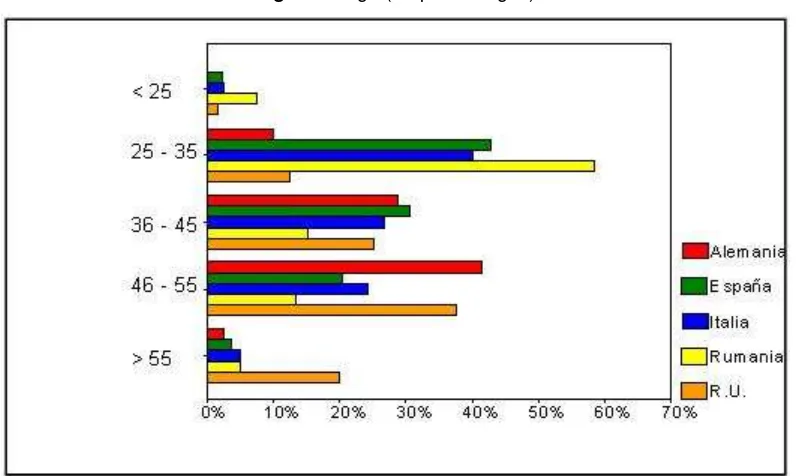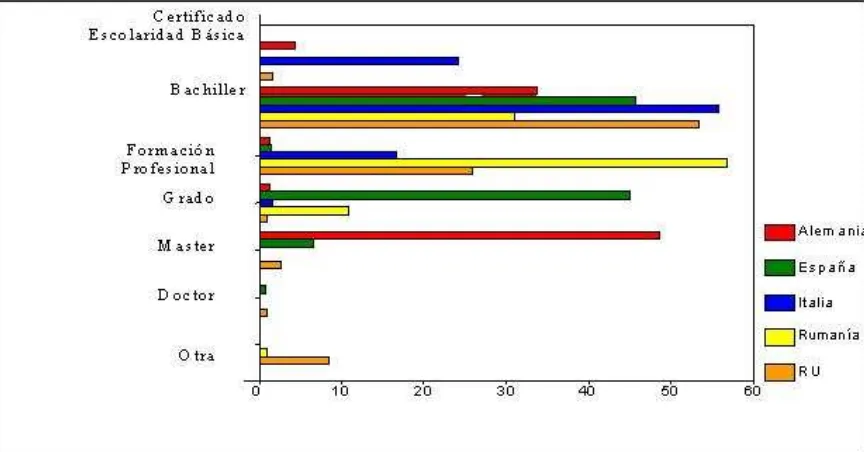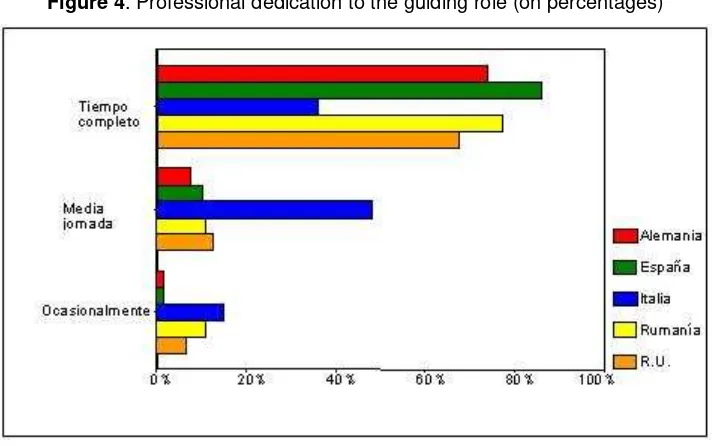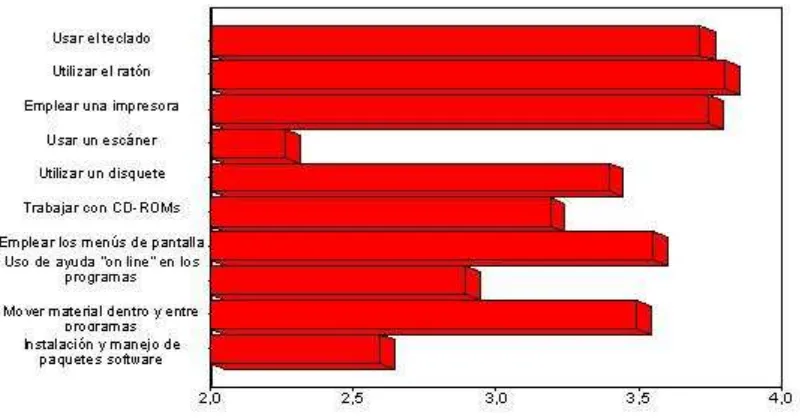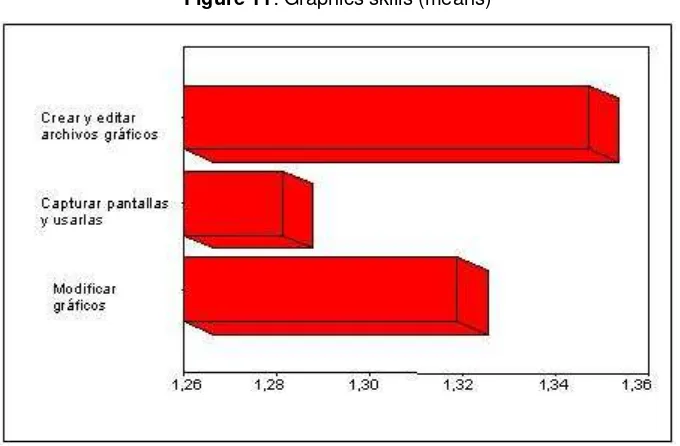M OD EL
OF
I CT
SKI LLS
AN D
N EW
PROFESSI ON AL
PROFI LE
OF
TH E
GUI D AN CE
COUN SELLORS
I N
SOM E
EUROPEAN
COUN TRI ES
Lu ís Sobr a do Fe r n á n de z; Cr ist in a Ce in os Sa n z; Re be ca Ga r cía
M u r ia s
Abstract
The article analyzes the using of the Information and Communication Technologies (ICT) in the
scene of some European countries in the Educational and Vocational Guidance area.
The design of the realized research has a main goals to diagnose the general and specific ICT
skills in the guidance practitioner´s profile and to know diverse guidance variables.
The guidance practitioners´total sample was constituded initially by 600 guidance practitioners (120
for each of five countries participants in the Project: Germany, Spain, Italy, United Kingdom and
Romania) and the definitive one belonged 578 participants.
As variables of the study, there is contemplated the age, training, professional experience and
professional dedication of the Guidance agents. Also, there was carried out an analysis detailed of
the general and specific ICT skills and its using by the Guidance practitioner and also a description
of some analyzed variables.
The most relevant conclusions attended users refer to the Guidance agent´s age, their training,
professional experience and the general and specific ICT skills.
Key words: Counsellor, Technology, Communication, Evaluation, Training
Introduction
The context for the inclusion of Information and Communication Technology (ICT) in the
processes of Educational, Personal, Social and Vocational Guidance in the European
framework is heterogeneous and so in some countries the discussion on this area is
highly developed, with various contributions in theoretical map and in the design and
developing of courses and specific training programs specially organized by the
Universities and Guidance Association. In other States and nations, the issue is still new
but the interest of Public Administration and the Guidance Associations is increasing
significantly, due in part to the impact of recent documentation of the European
Commission, CEDEFOP (European Center for Vocational Training) and other studies of
agencies in the international area such as the OECD, the World Bank, etc..
Since 1985, the European Union supported several International Conferences on
employment and the role of ICT and its conclusions regarding to the quality, the
interest for Guidance Practitioners, as guiding principles and support for the use of ICT in
guidance actions at personal, educational, social, family and professional scope.
One of the challenges that those responsible for the guidance system have to do face
today and increasingly in the future is the employment of ICT not only in the management
and information recording but also to provide services to their addressed (Ceinos, 2008).
All this implies the need to establish what are the emergencies and priorities to attend,
taking into account the quickly changes that new media of information and communication
contribute to the work of Guidance practitioners (Sobrado, 2006).
In this perspective, the training in the use of ICT in the guidance field arises peremptorily
and should provide to the agents models and criteria to prepare them not only to
diagnosing the existing resources based on ICT but also to generate new media and
teaching-technology material. It is also necessary to promote new attitudes to the use of
ICT in guidance actions for the purpose of qualifying to their protagonists in the new
technologies as information and communication tools to support the daily professional
activity and besides to help them to design new strategies and approaches in their work
(Cogoi, 2005).
1. The impact of ICT in the knowledge society
The term technology nowadays is used in different situations and therefore requires an
adequate conceptualization. Firstly, reference is made to information and communication
technologies as part of the link between natural and technique science. Also designates
the analysis of technological processes approaching with it to the interpretation of
reflection on the technical and thirdly it is also conceived as a set of technical and / or
procedures for an objective is the production of objects or the generation of behaviours.
The new way in which humanity interprets what comes to know, mainly through ICT
transforms fully the notion of know to consider at present that we are becoming in a
knowledge society (Castells, 2001).
Nowadays, the training appears as an investment and to achieve the benefits that it can
contribute is necessary that the transmission of knowledge suited to ICT, and for this is
necessary to reform the training systems in all their grades and levels.
The technical reason (Habermas, 1989) currently based in ICT and in changing of the
production and communication of knowledge calls for the replacement in post-industrial
On the way to this society, is postulated that through the knowledge is accessed to the
freedom and critical thinking through a life long training that makes of knowledge a value
of change.
In the analysis of this contemporary society, the information first and then the knowledge,
it appears obvious its role as the engine of productivity and its link with ICT. The
knowledge appears connection with the workplace by expressions such as "knowledge
management" or "knowledge economy". The new workers in this sector are driven to
make a lifelong training to acquire its complete adaptation to a system that request
flexibility but question the same notion of its, where the educational system in the middle
of the area responded to the call of the new "cognitive capitalism" (Pardo, 2009).
The term of knowledge society is created in the 1960 and so, in 1969 the sociologist
Drucker predicted the emergence of a new social class of workers who are no longer
devoted to the industry but also to the knowledge. This is now regarded as the basic
factor of production to be applied to what is already available services, products, etc.. as
well as innovation.
Drucker (1993) believes that knowledge is an effective information in the action and it is
based on the results and the starting point for this it is the information and its applicability.
Lane (1966) understand the knowledge society as one in which people are investigating
the foundations of their beliefs about humanity, nature and society, are guided by
objective standards of verification and deduction in the research, perhaps in a
unconscious way; devoted significant resources to research and therefore have a large
reservoir of knowledge and accumulate, organize and interpret the knowledge in an
ongoing effort to enlighten and perhaps transform their values and objectives as well as to
advance in them.
This delineation of the knowledge society is not include because the potential impact of
ICT is premature on the generation and processing of it and obviously not the huge social
changes that took the society in recent years and partially modifying the predictions of
Lane (Ballesteros, 2002).
Bell (2006) contains the proposals of Machlup on the "knowledge industry" and exposed
by Lane and added as an essential element of post-industrial society, the technology.
According to Bell, the post-industrial society is a society of knowledge because the
innovation comes from to research and development an increasing degree and that the
economy and the level of employability are in connection with the scope of it.
The model of knowledge is the scientific which represents the need of an appropriate
methodology, results and yields that can be quantified. The term information society is
employment.
The UNESCO facing to this perception essentially economistic retained by the term
knowledge society because better captures the complexity and dynamism of social and
cultural changes generated.
On the European stage recently noted the rise of the term knowledge society, understood
as that which concerns to the importance of ICT and to their use in processes of economic
projection.
This term also means new ways of generating knowledge in a society in which it is
together to the work and to the capital growth factor. In it, also stands out the relevance of
lifelong education and training and besides the complexity of intensive services in
knowledge and communication. In these descriptions arises the link that usually does
between ICT, education and knowledge society. The ICT creates knowledge and
simultaneously economic wealth and why its expansion will cause a society of which must
be encouraged from early childhood education to lifelong learning/training throughout
people's lives.
According to this perspective, the competitive potential of the knowledge society lies in
this educational promotion integrated with the technology.
2. The development programs of ICT in the European area
In the Europe scope, the e-Learning program from the European Commission was
constitute in the last years a model of technology applying in the lifelong learning.
The e-Learning initiative cited has as a purpose to mobilize to the cultural educational
communities and economic and social European agents to accelerate the evolution of
training systems as well as Europe's transition towards a knowledge society. Available at:
www.ec.europa.eu/education/programmes/elearning/ index_es.html and consulted at 11th
of November in 2008.
The e-Learning program was substituted for the period 2007-2013 by the Lifelong
Learning Program with a budget of seven thousand of million of euros, more or less, for
projects and exchange activities, cooperation and mobility between education and training
systems for European Union.
The aim is to transform these systems in concerning of quality in the field worldwide.
This program includes four subprogrammes which are in turn the Erasmus, Comenius,
Leonardo da Vinci and Grundtvig. It also has a cross program with four goals that are:
policy cooperation and innovation in the field of lifelong learning, promotion of language
learning, content development, services, pedagogies and innovative practices of lifelong
activities by the Lifelong Learning Program and of previous related programs as well as
exchange of good practices. Available at: www.ec.europa.eu/education/
programmes_es.html and consulted at 15th of March in 2009.
The Lifelong Learning Program seeks to make of the continuing training a privileged
instrument to form the social and cultural model to which leads the European Union.
Concerning to the presence of ICT in the new European program of action to the lifelong
learning, by decision of Parliament and European Council of 15th November 2006 (Official
Journal of the European Union of November 24th) establishing a new program of
cooperation in education and training 2007-2013, which includes in an integrated way the
old programs of the period 2000-2006 called Comenius, Erasmus, Leonardo da Vinci,
Grundtvig, Jean Monnet and other cross actions such as Lingua, ICT-Minerva, etc.
The total budget for the period 2007-2013 is to 6.970.000.000 euros as of January 2007.
The aim of lifelong learning program that is created, which should be considered to
contribute to it by the European Union to become an advanced knowledge society, with
sustainable economic development, through more and better jobs and with a greater
social cohesion (Marqués, 2000).
Within the framework of this new program are maintaining individual subprogrammes
aimed at the four major fields of training and education to increase the maximum
coherence and commonality between them and are the school education, the higher
education, vocational training and adult education ( due to the specificity of these sectors).
All of this because to the need of community action to be based on objectives, modes of
action and organizational structures designed specifically.
Also, for the attention to the growing need to support actions on the European stage,
designed to achieve strategic objectives, providing a tool to strengthen the intersectoral
action in the fields of languages and Information and Communication Technologies (ICT),
and also to make good use of the program's results is complementing the four sectoral
subprograms with a cross program.
The Lifelong Learning Program has among other specific objectives, contents,
pedagogies and innovative practices based on ICT. The sectoral sub-programs are the
following:
1º Comenius covering preschool and school education (primary and secondary).
2º Erasmus for higher education and vocational training at the tertiary level.
3º Leonardo da Vinci aimed at vocational training with excluding of the third sector.
The transverse program includes four key activities (cooperation and innovation in lifelong
learning, promotion of language learning, ICT development and dissemination of results
and exchange of best practice).
Furthermore, there is the Jean Monnet program within the framework of European
integration.
It may also provide support as the key activity relating to ICT, to the following actions: to
the guidance of the teaching and learning needs related to multilateral projects, for the
development and dissemination of services, methods, contents and innovation settings
and to multilateral networks of cooperation in order to share and exchange knowledge,
experiences and best practices.
In the objectives of the four major sectoral sub-programs (Comenius, Leonardo da Vinci,
Erasmus and Grundtvig) provides explicit the support to the development of services,
contents, pedagogies and practices of lifelong learning with innovative character and
ICT-based.
3. Objectives, methodology and research process made
As a result of the impact caused in the last years by the Information and Communication
Technologies in the guiding field, in this study, we intend to access to the information
necessary to describe the basic profile of practitioners who form the sample as well as
identify the technological skills used by guidance agents in the development of their
professional practice.
The sample involved in this study consists of 600 guidance practitioners who carry out
their professional activities in different European countries: Germany, Spain, Italy, United
Kingdom and Romania (120 in each one).
The instrument used in the process of data collection was a questionnaire designed to
analyze the training needs of counsellors in regard to the use of Information and
Communication Technologies. The selected variables for this study should be assessed
on a Licker scale of 0-4 (0: None, 1: Little 2: Something 3: Fairly, 4: Much). It was
responding a total collective of 578 Guidance Practitioners. Subsequently, a quantitative
and qualitative analysis of obtained data was perform by carrying out the evaluation of
various statistics, which had a purpose, mainly descriptive.
With regard to the variables to analyzed, we noted that these were the following: age of
counsellors, training of guidance practitioners, professional experience in the sector,
dedication to the guiding role; general competences in the use of ICT and specific skills in
the using of these resources: information processing, databases, reporting, graphics,
Identified these aspects, it should be noted that the obtained results in the research reflect
[image:7.595.107.505.152.390.2]the following:
Figure 1: Age (on percentages)
Distinguished by its youth the group of Romanians Counsellors (58%) between 25 and 35
years. To a lesser extent, those of Spain and Italy with values of 44% and 41%
respectively. In United Kingdom and Germany on the contrary the practitioners have a
average age perhaps higher because these countries have more tradition in the
implementation of Guidance Services. Also excels a 20% of the Guidance agents in the
United Kingdom over 55 years.
Concerning to the received training excels a 48% of Germany Counsellors with a Master's
degree and a 46% of Spain with the degree of Bachelor. Highlights the high percentage of
Italy Counsellors (82%) that only have basic studies (26%) and 56% of High School. In
United Kingdom and Romania , the most common training of them is the High School and
[image:8.595.90.522.87.313.2]Vocational Training.
Figure 3: Professional experience in Guidance (on percentages)
They excel in the professional experience the United Kingdom and Germany Counsellors
with rates of 52% and 46% respectively over ten years of work. The Romania and Italy
Figure 4. Professional dedication to the guiding role (on percentages)
Excel a 45% of Italians Counsellors that spend half a day to focus Guidance, while those
[image:9.595.139.472.422.645.2]of other countries beyond the 70% full-time.
Figure 5: Number of clients annually served by the counsellors (on percentages)
Outstanding the rates of Germany Guidance professionals (82%) and United Kingdom
(62%) that serving to the year more than 1000 users of Guidance services.
Highlights the averages of European Counsellors total group respondents in mastering on
basic training skills (keyboard, mouse and printer) with averages higher than 3'6 on a
scale of 0 to 5. However, the use of the scanner and the installation and management
[image:10.595.110.510.89.299.2]software packages has low values (2'2 and 2'6 of averages).
Figure 7: Word processing skills (means)
The data shown in the Figure above shows that those skills most used by practitioners are
the manipulation of text (3.5), formatting (3.4), use of writing tools (3.3) and the creation
and use of Figures (3.2). On the other hand, should be brought as those with a lower
Something similar happens with the creation of notes and the use of graphs, both with the
[image:11.595.101.510.151.361.2]same score (2.5).
Figure 8: Spreadsheet skills (means)
The values obtained here are lower half. The skills with a higher score focus on data input
(2.8) and manipulating of spreadsheets (2.6), while the lower score is obtained by those
based on the linkage of information between different pages and files ( 1.9), as well as
those concerning to the creation, manipulation and use of graphics (2.1).
Figure 9: Presentation skills (means)
After analyzing results shown in the graph above, shows that all skills that make up this
[image:11.595.122.485.485.693.2]ICT for preparing of simple presentations (2.65) , use of graphics and objects (2.35) and
[image:12.595.100.509.153.361.2]the design and development of more complex presentations (2.08).
Figure 10: Database skills (means)
The higher value is here the introduction and modification of data (2.2 average) and the
[image:12.595.136.476.432.655.2]other variables are low averages.
Figure 11: Graphics skills (means)
Given the results shown, it can be assumed that all the skills that make up this dimension
are little used by guidance agents, because the obtained scores are very close to the
value 1: create and edit graphics files (1.35), to modify graphics (1.3) and capture screens
and use them (2.19).
First, make it an acceptable assessment of the obtained results, all of them higher to the
the value 2. Highlight the basic skills for managing the tool (3.5), use of attachments (3.3),
an organization of email (3.2) and use of the address book (3), all of them fairly used by
all practitioners. Conversely, those with a lower result are related to the use of
[image:13.595.113.497.84.285.2]newsgroups (2.1), distribution lists (2.4) and create of a new email account (2.5).
Figure 13: Internet/ Intranet skills (means)
Virtually, all of the analyzed skills in this dimension reaching a positive score, except
refers to the use of Internet with WAP services (1.4). As skills enough used are those
relating to navigate on Web pages (3.4), using search (3.4), download materials (3.2) and
organize bookmarks (3).
[image:13.595.102.507.417.613.2]With higher scores than the value 2 highlights the management of a video (2.8), sending
SMS to mobile (2.7), use of a camcorder (2.2) and digital (2.1), where it appears that
some are used by technicians in Guidance. With lower ratings are those relating to
development and maintenance of ICT systems (1) network support (1.1), as well as
providing support to users of computing (1.8), all of them little used.
4. Conclusions
In view of the obtained results and the corresponding analysis related on them, highlights
the following aspects:
3 The Guidance practitioner profile in the five European countries analyzed is from a
young person in Romania, Spain and Italy and in middle-aged in the United Kingdom
and Germany. Regards to training is higher in Germany and Spain and lowest in Italy,
United Kingdom and Romania. Regarding to the professional experience highlights the
Guidance practitioners of Germany and the United Kingdom and lowest in Romania
and Italy. On the professional dedication excel the Italian agents of Guidance with a
45% who dedicate half time to the Guidance (with part-time) and on the number of
users served per year by each Counsellor highlights those of Germany and United
Kingdom with high percentages, 82% and 62%, respectively, serving more than one
thousand users annually.
3 The skills most used by practitioners refer to those of a general nature, those involving
word processing, email and related to Internet / Intranet.
3 Those who get a lower result, and therefore are the least used by the guidance agents
in the development of their professional work are related to spreadsheets,
3 There is the existence of certain differences regarding to the degree of using different
types of technology skills.
3 There is some relationship or connection between the preparation degree or the
training level needed to buy the different types of ICT skills and identified and the
degree of use of them. In other words, the level of training or preparation conditions
the use of technology skills, as with increasing the preparation required for their
acquisition and mastery diminishes considerably, the use that counsellors make of
them in developing of their professional work.
References
1. Ballestero, F. (2002). La brecha digital. El riesgo de exclusión en la sociedad de la Información.
Madrid : Fundación Retevisión.
2. Bell, D. (2006). El advenimiento de la sociedad post-industrial. Madrid: Alianza Universidad.
3. Castells, M. (2001). La era de la Información. Madrid : Alianza.
4. Ceinos, M. C. (2008). Diagnóstico de las competencias de los Orientadores Laborales en el uso
de las Tecnologías de la Información y de la Comunicación. Santiago de Compostela: Universidad
(Tesis Doctoral: inédita).
5. Cogoi, C. (2005). Using ICT in Guidance: Practitioners competent and training. Bolonia: Outline
Edizioni.
6. Consell Superior d'Avaluació del Sistema Educatiu de la Generalitat de Catalunya (2003).
Estudio sobre las competencias básicas en TIC. Disponible en: http://www.gencat.net
/ense/csda/htm
7. Cifras claves de las tecnologías de la información y comunicación en los centros escolares de
Europa. Accesible en: http://www.eurydice.org/resources/eurydice/ pd/0_integral /048ES.pdf
8. Drucker, P. (1993). Post-capitalist Society . Nueva York: Harper Collins.
9. Habermas, J. (1989). Ciencia y técnica como ideología . Madrid: Tecnos.
10. Lane, R.E. (1966). The decline of politics and ideology in a knowledgeable society. American
Sociological Review , 21, 5.
11. Marqués, P. (2000). Comunicación educativa y nuevas tecnologías. Barcelona: Praxis.
12. Pardo, C. (2009). Las TIC: Una reflexión filosófica. Barcelona: Alertes.
13. Simondon, G. (2008). El modo de existencia de los objetos técnicos. Buenos Aires: Prometeo.
14. Sobrado, L. (2006). Las competencias de los Orientadores en el ámbito de las TIC: diagnóstico
y desarrollo. Revista Estudios sobre Educación, 11, 27-43.
Received: november 2008
